Local Man Shows Off By Killing Dinosaurs (Prepare to Believe, part 4)
Creation Museum, Petersburg, Kentucky
Thanks for visiting Narrative Nation!
This is where I’ll collect some thoughts and images from my exploration of places with emotional significance for many Americans. Stops include Civil War and Revolutionary War sites and museums; Underground Railroad sites; state parks and historic homes; historical associations; and memorabilia and gun shops. To get a better sense of the narratives attached to historic places and the events and people they might commemorate, I look at the signage, collect the literature, and talk to visitors, staff, guides, and rangers. And of course, I mine the gift shops! Other places such as a Christian theme park, a convenience store, and a gun show help me consider how ideas about history influence current American fascinations, conspiracy theories, and cultural conflicts.
Some of this will be incorporated into the book I’m developing with the working title “Loads of Heresy”: White Supremacist Revisions of the American Narrative. For now these are drafts to help me think about what I’m seeing and hearing. If you’re new, you might want to start at the beginning of my road trip, or you might want to start at the beginning of the Creation Museum series.
Local Man Shows Off By Killing Dinosaurs (Prepare to Believe, part 4)
Building on observations from the fossil record, scientists have reached a conclusion about the earth’s history that pretty much jibes with what we already knew: male vanity appears to have been a driving force behind the extinction of dinosaurs sometime in the last few thousand years.
That’s human male vanity, not alpha dinos in a pissing contest to the death (but just imagine the smell!). I’m trying to be a serious writer here, so you can feel confident that I’m not making this up. “Answers in Genesis”—the people behind the Creation Museum in Petersburg, Kentucky—are.
In an earlier story about the Creation Museum, I wrote about the pseudoscience of “kinds” and “baraminology” used to replace accepted taxonomies and phylogenetic trees. In this installment, I’ll look more closely at the relationship between dinosaurs and dragons, along with the ways humans may have interacted with both of those. It took some work to figure this crap out, so I hope you’ll read on.
lingering just beyond the edges of our understanding
The classes dragon and dinosaur are connected but not interchangeable. First, let’s just try to absorb the what and when of these creatures according to the Creation Museum website and exhibits:
Their web page about the Dragon Legends exhibit offers the following by way of a definition:
What is a Dragon?
Before the word dinosaur (which refers only to land-dwelling creatures) was invented in the 1800s, the word dragon was used. Exhibits at the Creation Museum explain how that means all dinosaurs are dragons, but not all dragons are dinosaurs.
Of course this doesn’t really define dragon for us, but it does posit dragons as a pre-existing and larger category of which dinosaurs are a subset more recently distinguished by man.
The second sentence is more important to their alternate worldview than it may seem: the proposition “all dinosaurs are dragons” is essential because the Bible mentions dragons but not dinosaurs (in their interpretation of what the translations they use mean, since of course neither term literally appears in the original biblical texts). If dinosaurs are going to be admitted into reality by these people at all, they have to occur downstream from the ideas provided in the Bible.
In the description of one of the books sold at the museum and online, dragon legends are touted as a key to “man’s true history” but also as a “a shadowy mystery”:
Whether battling saints or terrorizing Aztec Indians and medieval maidens, these creatures provide a fascinating link to man's true history, and a shadowy mystery—lingering just beyond the edges of our understanding. (Dragons: Legends and Lore of Dinosaurs)
Beyond the edges of our understanding, indeed. This joyful subordination of something real to something fantastical is a necessary starting point to everything in the Creation Museum’s alternate universe, and so it follows that visitors enter the main building by walking through the hall of dragons.


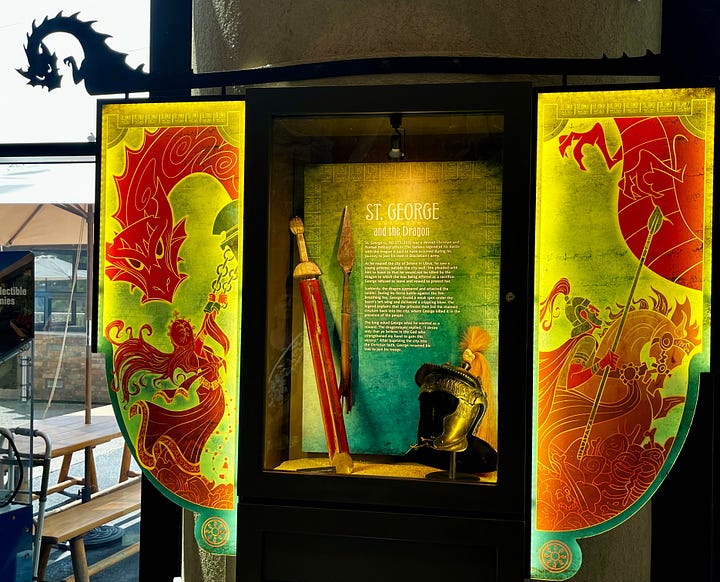
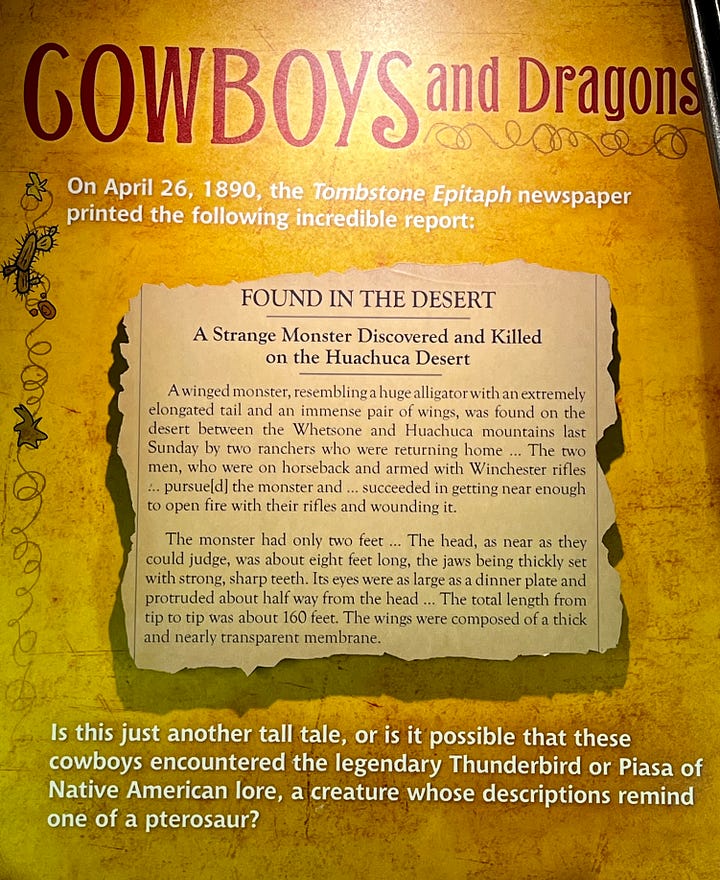
The narratives accompanying each dragon suggest these were real creatures, per the testimony of travelers and writers from around the world and across the centuries. St. George and the Dragon is important not only as another example of dragon lore, but as a popular story in which a hero is also a Christian proselytizer. But I was a little irritated to see Beowulf dragged into the whole thing.
The “Cowboys and Dragons” display is a good example of the Creation Museum’s shoddy and manipulative approach to establishing history. First, an outlandish report from the 1890 Tombstone Epitaph is used as primary source evidence without a corroborating source. It appears that a couple of cowboys saw a dragon-like creature in the desert and, quite naturally, pulled out their Winchesters and shot it. That checks out. Second, an absurd question is posed—”is it possible that these cowboys encountered the legendary Thunderbird?”—without considering the answer.
But what begins as a ridiculous question pops back up as established fact before long. As visitors continue their journey through the world of the Creation Museum, mankind’s literary descriptions of dragons are used like consensus science to support further false claims about the world. The signs—cartoonish maps and a super-meta drawing of a dragon reading about dragons--assert that these real dragons are the same historical creatures that have been labeled as dinosaurs in mainstream culture.
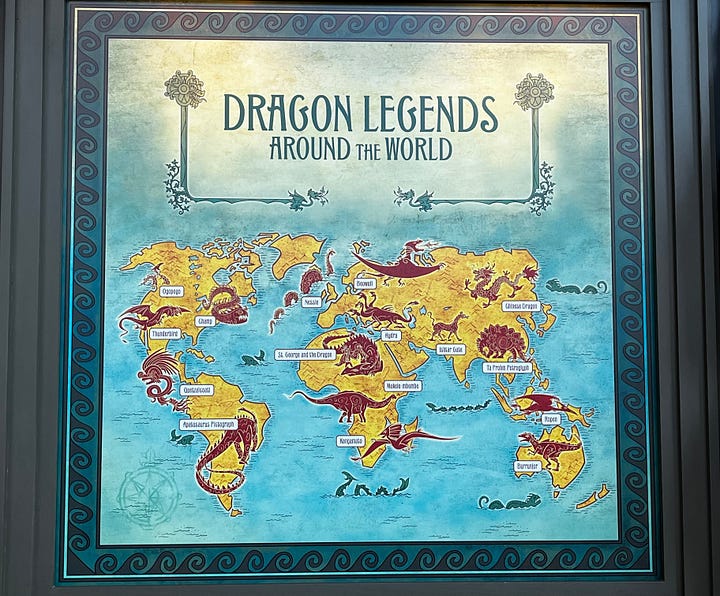


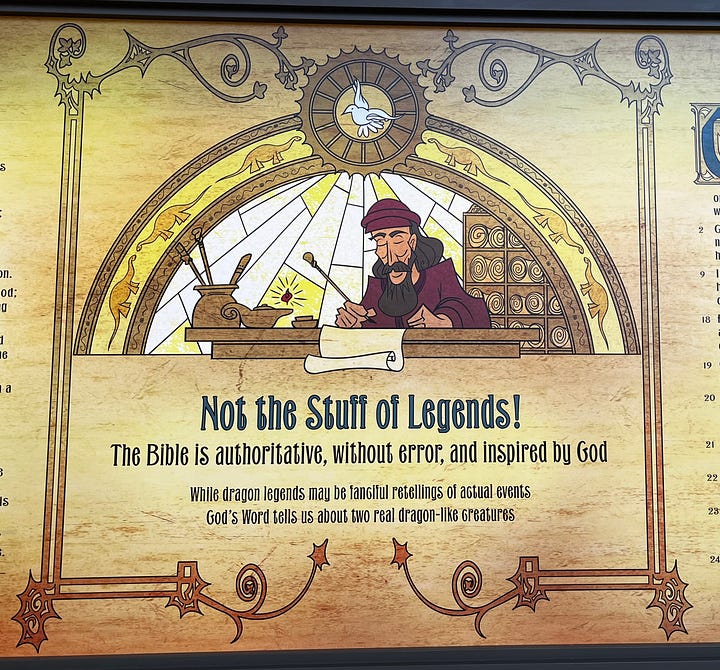
Visitors to the museum (and those who read their content online and in homeschool materials) learn all about the connection. Dinosaurs are the land-walking kinds of dragons that were carried on Noah’s ark as babies, something irrefutably proven with zero evidence. They don’t even have scripture to support this idea of young dinos on the ark—apparently about 80 “kinds.” Other kinds of dragons that could swim would not have needed a ride. Since some could also breath fire, I think we can agree the whole thing actually worked out, since we do know the boat was made of wood.
So, when Young Earth Creationists pose the question “what happened to the dragons?” on their website, they are asking what happened to all of the animals actual scientists would classify as dinosaurs, pterosaurs, and plesiosaurs.
What Happened to the Dragons? [which includes, remember, the dinosaurs]
Land and air dragons would have been taken on Noah’s Ark and probably existed for some time afterward, based on the descriptions we see in the Bible and legends and artifacts worldwide. But they died out due to the curse of sin, with factors such as environmental and habitat changes, food source problems, genetic mutations, and diseases. Also, man most likely played a role in the demise of dragons, as we read in the legends of dragon slayers.
It’s all a little confusing, but the Creation Museum’s 13-minute video provides some relief in the form of a narrative uncomplicated by evidence. I’ve included the entire video here because every minute of it is silly, but I will try to focus some comments on the way their narrative is delivered and why it matters.
If a middle-aged white guy in front of a fireplace doesn’t have all the answers, then I just don’t know how to sort fact from fiction.
The video is presented in several sections:
Intro: where Saint George is a legend, but the dragon is real.
The opening segment talks about the English legend of St. George and the Dragon. The serious narrator (the blue button-down up there, neither named nor credentialed in the video) acknowledges that the story of St. George killing the dragon, saving the princess, and asking the people to convert is “a myth, surely, an allegory filled with symbolism.” This feels like a rational start. But the narrator also assumes that “this strange creature” found “in the center of that myth” represents a real animal known to earlier English society: “Where did such a creature come from?”
That the story itself is classified as an allegory demonstrates the YEC mind is aware of the existence and function of this non-literal narrative mode. And this awareness makes it even more frustrating that they insist on taking the six days of creation so literally that all other facts are bent to serve that narrative. The difference, of course, is that the legend of St. George is not told in the Bible, so it can be safely discussed as an allegory. But since a literal interpretation of Genesis is sacred to them, they’ll commit to any amount of fraudulent reasoning to justify it.
This is not a hidden agenda. The objective is to take the Bible as God’s literal and infallible word (not subject to interpretation by man). Answers in Genesis materials explain that they must take the positions they do on various topics in order to avoid contradicting scripture. For example, in several places Ken Ham and his surrogates state flatly that dinosaur fossils simply cannot pre-date mankind because that would mean there was death before the Fall of Man. Genesis states that man was created first and that death was only invented as a punishment for man’s sin, so the YEC crowd cannot admit evidence for life and death before humans appear in the historical record. They also have a convoluted response and sell a little booklet to address the problem of carbon dating.
Chapter 1: Dragon Legends
Getting back to the video, the medieval manuscript illustration chosen to introduce the next segment does not depict dinosaurs—or any other “kind” of dragon—among the animals boarding the ark. Of course it doesn’t. Stegosaurs and other land-walking dinosaurs do not feature in Medieval, Renaissance, or Enlightenment art and literature.
Medieval storytellers are not known to skip the exciting parts, especially if dangerous creatures are involved. If dinosaurs were supposed to have been known to man from day one until some time well after the flood, why would they have fallen out of the narrative until fossils were identified in the 1800s?
Here’s something interesting that helps to make the point. When we look at an Anglo-Saxon rendering of the flood narrative, as in the 11th-12th century illuminated manuscript page shown here from the British Library collection, we see the ark depicted as a Viking ship with dragons, or sea monsters, carved on the prow and the stern. There are a lot of dragons throughout the Anglo-Saxon corpus, and Beowulf is one well-known example of dragon lore incorporated into an ultimately Christian text. The legend of St. George and the dragon, discussed above, is another.

But though there is dragon imagery in the carving on this Viking style ship, the only animals shown being transported on the ark are those known to co-exist with humans. Dinosaurs were never part of the flood story until Young Earth Creationism was invented in the early twentieth century.
“Chapter 1” of the Answers in Genesis video ends with great confidence. To begin, the narrator rightly states,
Many scientists contend the dinosaurs died off over 60 million years before humans came to be. The possibility that humans and dinosaurs co-existed is unthinkable to them. (3:35-)
This is a great start. Ernest Hemingway famously reminded himself, “All you have to do is write one true sentence.” This narrator has two of those in a row. But unfortunately he has more to say:
But what does the Bible say? Genesis 1 tells us that God made the animals of the land, air, and sea in the same week that he created human beings. Dinosaur fossils, believed to be laid down during Noah’s flood, suggest that dinosaurs were certainly alive at the time of Noah, only a few thousand years ago. And since the Bible tells us that Noah took pairs of every kind of land animal on board the ark, he certainly brought dinosaurs with him as well. (4:00-)
How long do I have for this? I’m not a scientist, but I know that repeating the hypothesis is not the same as presenting and explaining evidence. I also know that people weren’t hanging around with dinosaurs.
The smugly-delivered phrase “believed to be laid down during Noah’s flood” is really pushing it. That’s another true sentence, for sure, in the sense that this absurdity is “believed” by a group of people who ignore everything we know about geologic processes to interpret the physical evidence in support of their agenda. The two uses of the word “certainly” further imply that these claims are settled or at least that there is a preponderance of evidence of dinosaurs living a few thousand years ago.
While words like “certainly” and “suggest” and “tells” and “find” are used to describe the creationist narrative, the passage continues by using the word “assume” to describe the thought process of “many scientists” (which is nearly all the scientists).
This is consistent with recent discoveries of soft tissue and red blood vessels preserved in dinosaur fossils, a find that suggests dinosaur bones are not nearly as old as many scientists assume.
This is a prized claim, and the narrator can’t quite hide his smug excitement when he says these words. But click here for a non-technical 2015 article explaining why young earth creationists’ attempt to use Mary Schweitzer’s discovery of soft tissue in some dinosaur fossils doesn’t fly. One of the YEC talking points is that they look at “the same evidence” as the people they call “naturalistic” scientists. Okay, but all of the conclusions that could be drawn from the same evidence are not equally valid. They also have to make sense.
Even the invention of a category of scientists called naturalistic is a ploy to further their narrative of the “two competing worldviews.” Science is already the study of the natural world, right? Ultimately, so-called “creation science” is not science—it’s a blend of religion and conservative politics.
I’m really concerned about the damage this kind of thinking does to the minds of children raised in an environment in which such a thing is presented as fact. Dinosaurs walking around a few thousand years ago? Think of everything you have to not understand in order to allow that into your mind. Think of what else you might be led to believe once you’ve accepted something so impossible.
Chapter 2: Dragons in the Bible
Segments of the video are divided by an animated flame—must be dragon fire. They do not always logically follow the previous segment, but I think the ethos when watching these materials is just to go along with it and assume a point has been made by the end of each part. So here’s Chapter 2.
Another speaker appears, a man named Kurt Wise who is captioned as a paleontologist with a PhD from Harvard. I looked him up—Wise does have a degree in geology, and he is the Director of the “Creation Research Center” at Truett McConnell University, a college with about 2000 students in Cleveland, Georgia, operated by the Southern Baptist Convention and its appointed board.
Wise assures us that he looks at “fossils in the record” before returning the conversation to the words of the Bible.
There’s one possible place where the Bible describes a dinosaur, and it would be the behemoth described by God to Job. I suspect that the animal described in Job chapter 40, called the behemoth, is in fact a dinosaur that lived in the days of Job.
Okay Kurt Wise, if that’s all it takes, then I suspect you’re out of your goddamn mind. After presenting these two theories—that the behemoth and the leviathan described in the Book of Job were an apatosaur and a fire-breathing sea dragon—the video moves on as if the case for human co-existence has been made.
The first narrator steps back in to recap what we now know and conclude the section,
So if dinosaurs lived alongside humans, and Noah even brought pairs of young dinosaurs with him on the ark, what happened to them? Where did they all go?
It’s a tough question. But don’t worry, they only ask questions they already have the answers to—after all, they’re called Answers in Genesis, not Questions about Genesis.
Chapter 3: What Happened to the Dinosaurs?
The Creation Museum’s false sense of authority is enhanced by the propaganda strategy you can see in the screenshot below. The creation science conversation is presented on what looks like a medieval manuscript, visually suggesting that these are venerable questions and possibly that the Bible encourages us to believe this. But no one was ever trying to make this case in ye olde bookes.
Some of the text on the fake medieval-style manuscript questions what we think we know:
Are all the dinosaurs really extinct? Perhaps terrible lizards survive in some remote, unexplored corner of the world.
They’re not talking about Komodo dragons—the intention is to suggest that dinos might not even be extinct quite yet since, according to this “worldview,” they were walking around pretty recently. Visible sedimentary layers are no problem because they supposedly happened all at once as the earth settled during Noah’s flood. In the Museum I saw a really stupid graphic, which was really just a bunch of lines, meant to explain how this would happen.
Elsewhere in the video, Wise explains why the dinosaurs went extinct. First, he notes that gymnosperm plants are commonly found along with dinosaurs in the sedimentary layers. He concludes this was their main source of food. The next sentence typically only gives the illusion of connecting that idea to the conclusion: somehow because they ate a certain type of plant that is no longer common today, he concludes that the dinosaurs had limited food after the flood. The lack of food kept the population down, he explains,
making it possible—and this is what I believe happened to them ultimately—for humans to pick them off, to kill them. Perhaps humans killed predatory dinosaurs because they were afraid of them, or, because they wanted to show off.
I can totally picture it! We all know guys like that. But however it went down, the dinosaurs are all gone now. And that could have happened at any time since the great flood. Unless some are still hanging around.
Whoaaa — look out!
evidence of a different history
After the video’s three chapters, the scene changes to a fake dino dig. The main host introduces us to “fellow paleontologist” Kim. Though they supposedly went to college together,
Today we study the same fossils, we use the same techniques, but that doesn’t mean we agree on what happened here. We do interpret our findings differently. You see, fossils don’t come with tags on them telling us how old they are . . .
There’s a lot wrong with this, but the core of the lie is the claim to “use the same techniques.” Throughout the Creation Museum and Answers in Genesis materials, they argue that the methods of trained paleontologists and geologists yield incorrect data supporting the theory of an old earth. Their failure to use and understand accepted techniques may be one of the reasons they stand around hoping someone turns up a fossil that still has the tag on it.

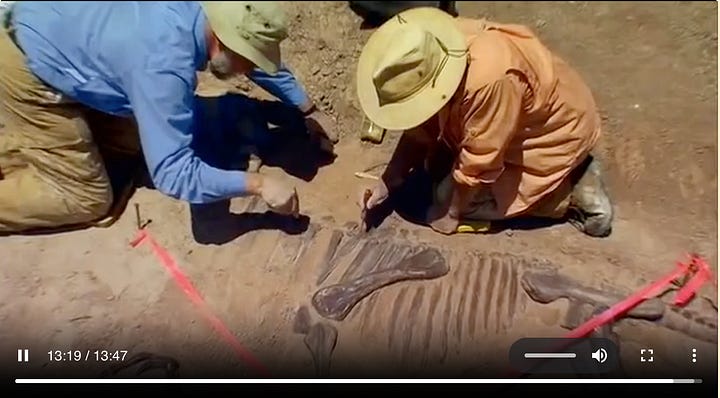
Kim holds up a fossil and explains why he thinks it’s about 100 million years old. “But,” the narrator says, “I see evidence of a different history.” Though Kim looks up at the camera like he’s being held hostage, we’re assured that they’re friends who look at “the same facts” but “interpret the facts differently” and draw “different conclusions.” The divergence is chalked up to simply having “different starting points”—the narrator begins with the Bible and Kim doesn’t.
This may seem like a peaceful way to address a cultural crux, but I think it’s more important to recognize a narrative strategy meant to sow distrust in science by suggesting there are legitimately “two sides” when in this case only one of those sides has any credibility whatsoever. It’s another version of the disingenuous “competing worldviews” tactic discussed in my previous post.
[Also, click here for a 2020 article warning biology teachers to get ready for students whose upbringing or influences will make them susceptible to recent claims that radiocarbon found in some fossils validates the young earth creationist theory. It doesn’t.]
certain beetles
But—just to be sure—let’s briefly test the “both sides” thing with an assertion from the Creation Museum web page. The page “Dragons: Fact or Fable” tries to legitimize the question of whether humans co-existed with dragons (which includes dinosaurs):
Dragons and Humans—Together?
For evolutionists, legends of men slaying dragons must be mythical because their timeline has creatures like dinosaurs die out over 60 million years before humans existed. But dragon accounts aren’t easy to dismiss as mere fantasy.
Certain beetles shoot out burning chemicals, so is a fire-breathing dragon really that far-fetched?
Here are the two sides:
Creation Museum side: (a) we at the Creation Museum don’t understand or will pretend not to know how insects synthesize (and in some cases heat nearly to the boiling point!) chemicals that produce a burning sensation; but (b) coming from that place of ignorance, we feel comfortable leapfrogging to any other idea; so (c) because we’re always looking for ways to make dragon legends into literal historical records, we will say that insects secreting liquid chemicals is biologically analogous to reptiles breathing fire.
My side: (a) yes, a fire-breathing dragon is a bonkers proposition; so (b) stop infecting the suggestible minds of young people with your bullshit and imperiling their futures by presenting illogical connections as a valid form of reasoning.
Putting dinosaurs and humans on the same page of history allows the Creation Museum to sustain the Young Earth argument during which humans and land animals were invented on the same ordinary day, the sixth day. It also protects the idea, presented later in Genesis, that death never existed before man sinned in the Garden of Eden. The extinction of dinosaurs before the advent of humans totally wrecks that narrative, so it has to be denied no matter how absurd the resulting argument.
But after spending a day at the Museum to learn man’s true history, and also remembering that apparently the sea monsters and flying dragons (creatures of the sea and of the air) were created on the fifth day, I think I understand them a little more. It’s probably that first whole day without a name, without any attention from Adam, without any Adam at all, that made them such angry and alienated creatures, hanging around the margins of the known world breaking things and eating people.
But the land dragons, what today we call dinosaurs, were created on the same day as humans and named within a few hours at the most. Certainly that sense of belonging accounts for historical images like these, where we see Jesus and Santa Claus and lots of ordinary humans living in harmony with dinosaurs. You don’t even need to travel to Petersburg, Kentucky like I did—there’s actually a ton of evidence for this available online:






Is there even more to learn about our world?
In my next post, I’ll look at Creation Museum CEO Ken Ham’s refutation of some prominent Christians who really get under his skin. I’ll also discuss Ham’s long-haul misinformation campaign and how it contributes to the current upsurge in the culture wars attack on public education led by people like Christopher Rufo.






Well, given this new information and watertight reasoning, I must reconsider everything I think I know about the natural world. I mean, if beetles can burn... After reading this, there’s really only one thing of which I’m certain. And that is, that you, lady, are on fire!
Thank the Almighty that you included the Jesus on a Dino imagery, I was waiting with bated breath, and you would have surely lost me without said inclusion. I don't even know where to begin with the Creation Museum. This is local to me, though rarely comes into discussion with visitors to my history center job. This may not be the case with other areas of the library, but it seems most history enthusiasts and genealogy researchers are focused on more grounded tasks. Recently I was a panelist at a preservation conference and was introduced as hailing from the "Birthplace of American Vertebrate Paleontology" (Big Bone Lick State Historic Site/Park.) The moderator then mentioned that "conicidentally, also the home of the Creation Museum." Ahem. Very clever on her part and I was in good company in terms of my views, but still pretty mortifying to acknowledge.
There's so much to unpack here, but my mind goes to marketing, always, with this group. The content of their short films is cheesy but the production value is not cheap. They also have notably expensive facilities and displays. This is the driver behind the interpretive loopholes in their otherwise rigid views. I looked at the "paleontologist" Kurt Wise, there was a series of short videos that I didn't bother to watch, but one was titled "The Days in Genesis are Millions of Years Long." Well, problem solved, huh? Excuse the vernacular, but I just can't with these fools.